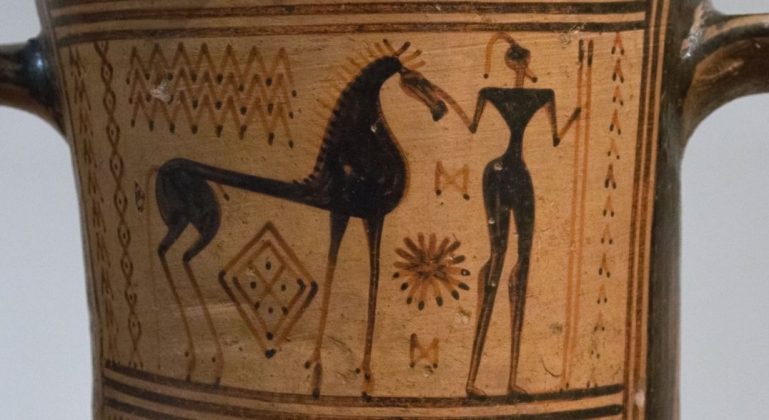The striking, nearly 5-foot tall Dipylon Amphora, from approximately 700 BC, is a masterpiece of the art of Ancient Greek pottery. Its exquisite painted exterior shows a funeral scene with wasp-waisted human and stylized animal figures alongside geometrical shapes and patterns. Discovered in Kerameikos, Athens at a gate called Dipylon at the entrance to an ancient cemetery there, the maker of this gigantic piece, along with all the others who created ancient Greek masterpieces of pottery, has always been assumed to be male. Indeed, the artisan here is always referred to by historians as the “Dipylon Master.” But what if the creator of this striking grave marker, and many other pieces of pottery, was actually female? Sarah Murray, a classical archaeologist from the University of Toronto, along with two of her undergraduate students, are questioning long-held beliefs in this arena.
They believe that not only did females participate in the making of artistic pottery but that they were primarily responsible for the creation of ceramics in the early Greek Iron Age, which lasted from 1050 BC to 700 BC. Unfortunately, there are no written records extant which date back to that era. Indeed, pottery itself serves as much of the historical record of these times in Greece. Murray says in a new article in the American Journal of Archaeology:
“Pottery is the anchor of everything we say about the society—but I think that’s problematic. No one had really thought that women were involved in making this pottery. There was no argument. It was just taken as the default.”
Indeed, most indisputable historical records from all the eras in Greek history show that it was for themes part a clearly male-dominated society. However, Murray and her team posit the theory that, due to huge societal shifts which took place between the preceding Bronze Age, which represented a high point in artistic expression of every kind in Greece, and the Iron, women may have taken on new roles and begun to create pottery as well.
The Iron Age differed from the previous era in many ways — there was a measurable drop in population from the previous Bronze Age, something which, Murray says, leads to women stepping into the breach and beginning to create pottery themselves.
This situation may not have continued into what is called the Archaic Age, with its rebound in population and the concomitant social classifications which accompanied it — but for this time period, it is entirely possible, according to Murray, that females put their mark on the Ancient Greek art of fine pottery.
Additionally, as seen on the Dipylon vase above, there is a sudden and marked emphasis on geometric patterns such as zigzags and diamonds, representing an enormous change from prior pottery decoration.
Murray believes that this may actually be a recreation of the geometric patterns used in weaving — which was purely a female art at the time.
“The fact that the style seems to be inspired by textiles is kind of like the big, blaring horn. Women are almost always the weavers.”
The fact that the Dipylon vase itself portrays mourners is another tell for Murray, who explains that women always had played a huge role in funeral rituals, including preparing the bodies and even being professional mourners, roles which go across nearly all human civilizations.
Additionally, most Iron Age pottery carries motifs of women’s daily lives — weaving and doing other typically female chores. Later pottery from the Archaic period often was decorated with battle scenes and even poetry, retelling epic battles.
At the present time there is research being undertaken to closely examine pottery for impressions of the fingerprints of the ancient potters, which may shed light on the gender of the person who created the piece.
Julie Hruby, a classicist from Dartmouth College, is zeroing in on using this new technology to finally determine who these ancient potters might be, creating a new method for analyzing prints. She states
“I would be surprised if I found fingerprint evidence that refuted what was in (Murray’s) article.”

 Khaire! Would you buy me a coffee?
Khaire! Would you buy me a coffee?
No comments:
Post a Comment